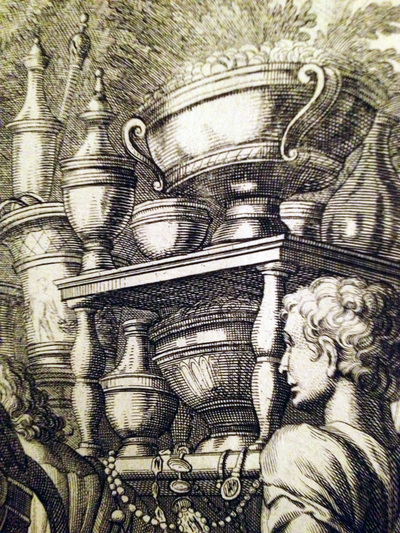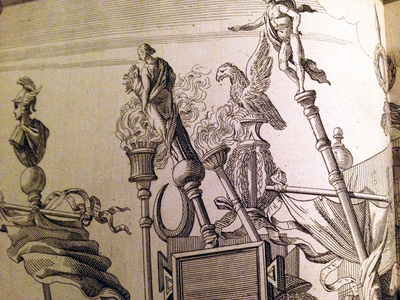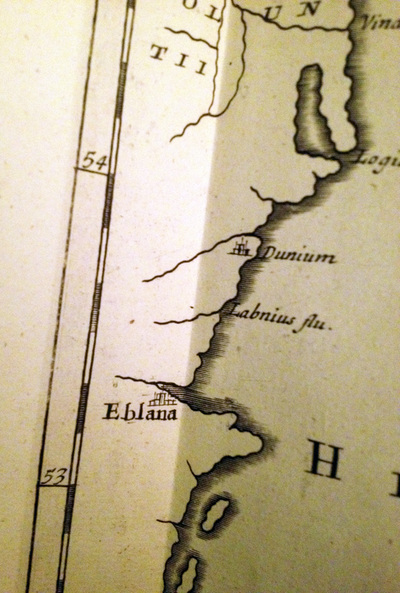The Commentaries of Caesar translated into English To Which is Prefixed a Discourse Concerning the Roman Art of War, Caesar, Julius; Duncan, William.
|
DUNCAN, WILLIAM.
Caesar's Note to go with the Scans.. Price: $20,000 Buy Now and Price: $18,000 Buy Now I have two editions by the same publisher of this famous folio book. The Commentaries of Caesar translated into English. To Which is Prefixed a Discourse Concerning the Roman Art of War 1753 Published in London: By Tonson, Draper, and Dodsley, 1753. 1st. Edition Elephant Folio, full contemporary calf with elaborately gilt-decorated spine, with worn contemporary brown leather binding. 1st. Edition of Duncan’s famous translation of Caesar’s Commentaries, sumptuously illustrated with frontispiece portrait of Caesar, this copy with the famed double-page bull plate, often not present, in the the magnificent "Duncan Caesar", the most beautiful and celebrated edition of Caesar’s Commentaries in English, complete with 50 superb double folio engravings, and 6 fold-out maps and 21 full folio page engravings, with a frontispiece of Caesar, and 5 foldout double engravings. All engravings are present in the two copies. The two folio books are In Stunning condition, the $18,000 has a few repairs to the battered cover, but has all its engraved plates in situ. The better folio book at $20,000 has in comparison a few minor professional repairs to the top of the Bull engraving. Text exceptionally clean. A stunning, wide-margined copy. RARE, particularly complete and in such fine condition in original, untouched binding. William Duncan was born in Aberdeen in 1717, and died in Aberdeen in 1760;- He was a Scottish natural philosopher and classicist, professor of natural philosophy at Marischal College, Aberdeen. Educated at Marischal College, Aberdeen, he was appointed professor of natural philosophy there in 1752. His popular Elements of Logic, first published in Robert Dodsley’s The Preceptor (2 vols, London, 1848), combined a Lockean theory of knowledge with syllogistic logic. He translated the Commentaries of Julius Caesar and orations of Cicero;- at his death, translations of Plutarch’s Lives and a continuation of Thomas Blackwell’s Court of Augustus were left unfinished. "The ablest Commander of the most warlike People on Earth entertains You with the History of his own Campaigns. You are informed of the Motives which determined him in all his Enterprises, of the various Difficulties he had to encounter, and of the Steps by which in the end he was enabled to surmount all Opposition. In a Word, Prudence in Counsel, Courage and Intrepidity in the Field, a calm Presence of Mind in the midst of Dangers, and an amazing Dexterity in sudden and unforeseen Emergencies, are here exemplified in the Conduct of a Leader, whom all succeeding Ages have agreed to regard as the most finished Pattern of military Merit." -William Duncan "It were doing the Work an Injury to suppose [the engravings] merely ornamental. For besides that they serve to illustrate the Antiquities, Habits and religious Ceremonies of the several Nations mentioned in the Commentaries; if it be considered, that the far greater number are Plans of Battles, Sieges, and Incampments... their great Subserviency towards a due Understanding of the History will abundantly appear. When the whole is subjected to the Eye in a distinct and accurate Delineation of every Circumstance, we become in a manner, Spectators of the Action." -William Duncan ENGRAVINGS BY Andrea Mantegna (1431 – September 13, 1506) was an Italian painter, a student of Roman Archeology, and son in law of Jacopo Bellini.Like other artists of the time, Mantegna experimented with perspective, e.g., by lowering the horizon in order to create a sense of greater monumentality. His flinty, metallic landscapes and somewhat stony figures give evidence of a fundamentally sculptural approach to painting. He also led a workshop that was the leading producer of prints in Venice before 1500.Many of the Engravings in The Commentaries of Caesar translated into English by William Duncan are by Andreas Mantinea (Andrea Mantegna) (1431-1506)Aliases: Andrea da Padova; Andreas Mantinea;- Professions: Painter; copperplate engraver(b 1431, Isola di Cartura; d 1506, Mantova) Italian Renaissance painter, copperplate engraver. He influenced such artists as, Correggio, Rafael and Albrecht Dürer. Engravings of Mantegna was no less eminent as an engraver, though his history in that respect is somewhat obscure, partly because he never signed or dated any of his plates, but for a single disputed instance of 1472. The account which has come down to us from Vasari (as usual keen to assert that everything flows from Florence) is that Mantegna began engraving in Rome, prompted by the engravings produced by the Florentine Baccio Baldini after Sandro Botticelli. This is now considered most unlikely as it would consign all the numerous and elaborate engravings made by Mantegna to the last sixteen or seventeen years of his life, which seems a scanty space for them, and besides the earlier engravings indicate an earlier period of his artistic style. He may have begun engraving while still in Padua, under the tuition of a distinguished goldsmith, Niccolò. He and his workshop engraved about thirty plates, according to the usual reckoning; large, full of figures, and highly studied. It is now considered either that he only engraved seven himself, or none. Another artist from the workshop who made several plates is usually identified as Zoan Andrea.Among the principal examples are: Battle of the Sea Monsters, Virgin and Child, a Bacchanal Festival, Hercules and Antaeus, Marine Gods, Judith with the Head of Holophernes, the Deposition from the Cross, the Entombment, the Resurrection, the Man of Sorrows, the Virgin in a Grotto, and several scenes from the Triumph of Julius Caesar after his paintings. Several of his engravings are supposed to be executed on some metal less hard than copper. The technique of himself and his followers is characterized by the strongly marked forms of the design, and by the parallel hatch marks to produce shadows. The closer the parallel marks, the darker the blacks were. The prints are frequently to be found in two states, or editions. In the first state the prints have been taken off with the roller, or even by handpressing, and they are weak in tint; in the second state the printing press has been used, and the ink is stronger. |




































